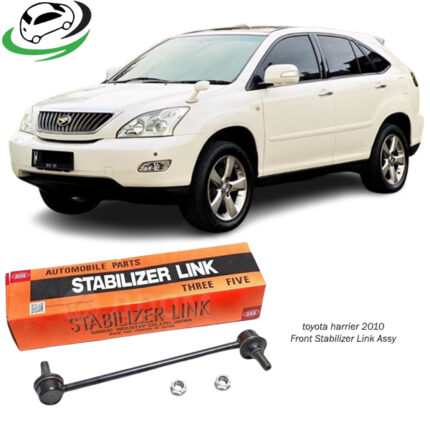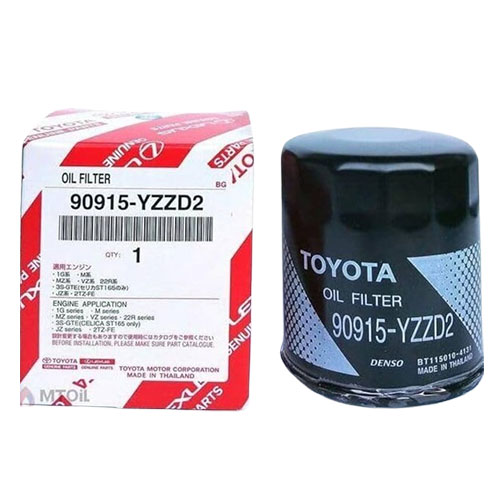-10%
Get Genuine Oil Filter Element Assy 90915-YZZD2 in Kenya
Under the hood of every engine lies a complex system working hard to keep your vehicle running smoothly. While many parts grab attention—like spark plugs, injectors, or timing belts—there’s one component that silently ensures the engine’s long life and smooth performance: the oil filter. More specifically, the Genuine Oil Filter Element Assembly.
Though small in size, this critical part plays a massive role in keeping the engine clean, protected, and running at peak efficiency. Let’s take a closer look at what it does, how it works, and why choosing a genuine filter element makes a world of difference. 🚗🛠️
🔍 What Is an Oil Filter Element Assembly?
The Oil Filter Element Assembly (also known as the oil filter cartridge or insert) is the part of the engine that filters out impurities and contaminants from engine oil. These can include:
-
Carbon deposits from combustion
-
Metal shavings from engine wear
-
Dust, dirt, and sludge
-
Oxidation byproducts
Modern vehicles use either spin-on filters or cartridge-style filters. The Genuine Oil Filter Element Assembly refers specifically to the internal filter media that sits inside a housing and can be replaced during oil changes. 🧽🛢️
🧠 Why Is Filtering Engine Oil So Important?
Engine oil lubricates moving parts, reduces heat, and prevents metal-to-metal contact. But over time, the oil picks up contaminants. Without proper filtration, this dirty oil can lead to:
-
Increased engine wear
-
Poor performance
-
Sludge buildup
-
Shorter engine lifespan
-
Costly repairs
The oil filter traps these contaminants and prevents them from recirculating through the system. This ensures that the oil remains clean enough to do its job efficiently. 🧼⚙️
⚙️ Key Components of a Genuine Oil Filter Element Assy
Not all oil filters are made equal. A genuine filter element stands apart due to its precision engineering, high-quality materials, and manufacturer-approved design. Here’s what makes it special:
✅ 1. High-Efficiency Filter Media
The core of the filter is a pleated material (often synthetic or cellulose) that catches and holds contaminants without blocking oil flow. Genuine filters are tested to remove microscopic particles while maintaining strong oil pressure. 🔬🔄
✅ 2. Robust Structure
The pleats are held in place by durable end caps and a central tube that prevents collapse under pressure. Some filters also have anti-drain-back valves to prevent oil from draining out when the engine is off.
✅ 3. Precision Fit
Genuine filter elements are made to fit perfectly within the engine’s housing. A tight seal ensures no oil bypasses the filter, which can happen with poorly-made alternatives.
✅ 4. Heat and Chemical Resistance
High-quality rubber seals and gaskets used in genuine filters resist degradation from heat and exposure to various engine fluids. This helps maintain a leak-free system. 🧪🔥
🛠️ How It Works: The Filtration Process
-
Oil is pumped from the oil sump to circulate through the engine.
-
Before reaching vital components, it is directed through the oil filter.
-
The oil flows through the filter media, where contaminants are trapped.
-
Clean oil exits the filter and continues lubricating the engine.
-
Over time, the filter fills with particles and must be replaced to maintain effectiveness.
This entire process happens in fractions of a second—hundreds of times per minute—making the filter one of the most active components in your engine. 🏁💨
🔧 Benefits of Using a Genuine Oil Filter Element
Choosing the right oil filter isn’t just about preventing engine damage—it’s about optimizing your vehicle’s performance and extending its life. Here’s why using a genuine oil filter element makes sense:
🔹 1. Superior Filtration
Genuine filters meet strict quality standards set by vehicle manufacturers. They remove more contaminants and hold more debris over time without restricting oil flow.
🔹 2. Longer Engine Life
Clean oil means less friction, less heat, and less wear on critical parts like pistons, camshafts, and bearings. Over time, this translates into a more durable engine. 🧰🔧
🔹 3. Consistent Oil Pressure
A genuine filter ensures your oil pressure remains stable—especially at cold starts and high speeds—reducing the risk of engine damage.
🔹 4. Reduced Maintenance Costs
By keeping oil clean and flowing, you reduce the chances of breakdowns and extend the intervals between major engine repairs.
🔹 5. Peace of Mind
Genuine filters are tested and validated for your engine. There’s no guessing, no compromises—just trusted protection.
⚠️ What Happens with Low-Quality or Fake Filters?
Using counterfeit or low-grade oil filters can be risky. These often use:
-
Poor-quality filter media
-
Weak seals that allow oil leaks
-
Incorrect fitment
-
Inconsistent filtration performance
This can result in unfiltered oil circulating through your engine, increasing the risk of:
-
Engine sludge
-
Premature wear
-
Oil starvation
-
Engine overheating
🚫 Don’t risk it—stick with genuine parts designed for optimal performance.
🔁 When Should the Oil Filter Element Be Replaced?
The oil filter should be replaced every time the engine oil is changed. Depending on the vehicle and oil type, this is usually every 5,000 to 10,000 kilometers or 3,000 to 6,000 miles. However, consult your service manual for exact intervals.
Frequent oil and filter changes are a small investment that pays big dividends in engine health. ⏳🛢️
🧰 Installation and Maintenance Tips
Replacing a cartridge-style oil filter involves the following:
-
Drain the old engine oil.
-
Remove the oil filter housing cap.
-
Take out the old filter element and O-ring.
-
Install a new genuine filter and new O-ring.
-
Reinstall the housing cap and refill with fresh oil.
-
Start the engine and check for leaks.
It’s always a good idea to have this done by a professional mechanic or technician if you’re unfamiliar with oil changes.
🌍 Environment and Disposal
Used oil filters contain old oil and contaminants, so they should be disposed of responsibly. Many service centers and auto shops offer eco-friendly recycling options to ensure proper handling of used filters. 🌿♻️
✅ Conclusion: Protect Your Engine the Right Way
The Genuine Oil Filter Element Assy might be small, but its impact is massive. It protects your engine from unseen threats, helps maintain oil purity, and ensures smooth performance over the long haul.
By choosing a genuine filter, you’re not just replacing a part — you’re investing in engine longevity, reliability, and peace of mind. It’s a simple yet powerful way to ensure that every drop of oil works as hard as it should, every time you start the engine.
Follow us on Facebook for more parts.



